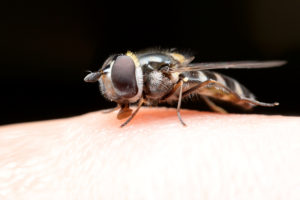 The common name of small fruit fly comes from their small size and fondness for fruits as egg laying and developmental sites. The name of vinegar fly comes from the fact they develop in the briny or vinegar-like liquids at the top of imperfectly sealed canned fruits and vegetables. These are nuisance pests but may act as disease vectors. They are also worldwide in distribution and are found throughout the United States.
The common name of small fruit fly comes from their small size and fondness for fruits as egg laying and developmental sites. The name of vinegar fly comes from the fact they develop in the briny or vinegar-like liquids at the top of imperfectly sealed canned fruits and vegetables. These are nuisance pests but may act as disease vectors. They are also worldwide in distribution and are found throughout the United States.
Adults are about 1/8″ (3-4 mm) long, including the wings. Color dull, tan to brownish yellow or brownish black; eyes usually bright red.
BIOLOGY
Adult females lay their eggs (average about 500) near the surface of fermenting fruits and vegetables or near The cover crack of imperfectly sealed containers of such materials. The eggs hatch in about 30 hours. The larvae develop in the briny or vinegar-like liquids of the fermenting materials where they feed near the surface and primarily on the yeast, for about 5-6 days. Prior to pupation, the larvae crawl to drier areas of the food or elsewhere. The brown, seed-like sheath containing the pupa (the puparium) is formed from the last larval skin/exoskeleton. The newly emerged adults mate in about 2 days. The life cycle (adult to adult) may be completed in 8-10 days at 85°F (29°C). Their reproductive potential ,s enormous.
HABITS
Small fruit flies are attracted primarily to fresh fruits and vegetables and those fermenting because of yeast. Materials lose their attractiveness when they begin to decay because of bacteria and fungi. Materials commonly infested include bananas, grapes, peaches, pineapples, tomatoes, mustard pickles, potatoes, etc. and fermenting liquids such as beer, cider, vinegar, and wine; some species are attracted to human and animal excrement. The larvae develop primarily in liquids and near the surface but seek drier areas for pupation. Newly emerged adults are attracted to lights. Because of their short life cycle of 8-10 days, they can exploit many temporarily available developmental sites such as sour mop and broom heads, fruit under a table or cabinet, fruit left out in a bowl, etc. Dishwater and mop water full of food particles can accumulate on surfaces and/or in crevices and ferment, providing ideal fly breeding conditions. Adults tend to hover in small circles. Because of.their small size, many species are able to penetrate ordinary screens
CONTROL. The key to small fruit fly control is sanitation. Elimination of larval food and developmental sites is mandatory. The presence of adult flies usually means that larvae are developing in some nearby fermenting material. If the flies are coming from outdoors, reducing the screen mesh size can be helpful because most species can penetrate ordinary screens. The number cf adults can be reduced through the use of insect electrocuters (light traps), and/or better. the use of baited jar traps with special tops which allow access but discourage escape. Adults can be easily killed with an appropriately labeled aerosol or ULV application. However, such relief will only be temporary, lasting only until new adults emerge, unless proper sanitation has been practiced.
